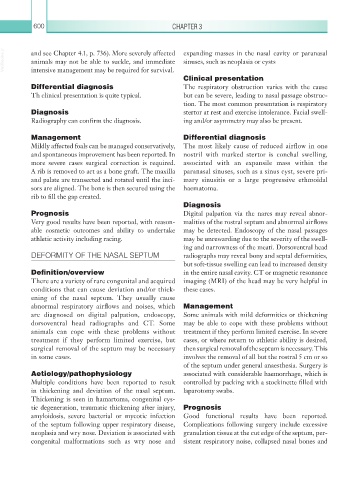Page 625 - Equine Clinical Medicine, Surgery and Reproduction, 2nd Edition
P. 625
600 CHAPTER 3
VetBooks.ir and see Chapter 4.1, p. 736). More severely affected expanding masses in the nasal cavity or paranasal
sinuses, such as neoplasia or cysts
animals may not be able to suckle, and immediate
intensive management may be required for survival.
Clinical presentation
Differential diagnosis The respiratory obstruction varies with the cause
Th clinical presentation is quite typical. but can be severe, leading to nasal passage obstruc-
tion. The most common presentation is respiratory
Diagnosis stertor at rest and exercise intolerance. Facial swell-
Radiography can confirm the diagnosis. ing and/or asymmetry may also be present.
Management Differential diagnosis
Mildly affected foals can be managed conservatively, The most likely cause of reduced airflow in one
and spontaneous improvement has been reported. In nostril with marked stertor is conchal swelling,
more severe cases surgical correction is required. associated with an expansile mass within the
A rib is removed to act as a bone graft. The maxilla paranasal sinuses, such as a sinus cyst, severe pri-
and palate are transected and rotated until the inci- mary sinusitis or a large progressive ethmoidal
sors are aligned. The bone is then secured using the haematoma.
rib to fill the gap created.
Diagnosis
Prognosis Digital palpation via the nares may reveal abnor-
Very good results have been reported, with reason- malities of the rostral septum and abnormal airflows
able cosmetic outcomes and ability to undertake may be detected. Endoscopy of the nasal passages
athletic activity including racing. may be unrewarding due to the severity of the swell-
ing and narrowness of the meati. Dorsoventral head
DEFORMITY OF THE NASAL SEPTUM radiographs may reveal bony and septal deformities,
but soft-tissue swelling can lead to increased density
Definition/overview in the entire nasal cavity. CT or magnetic resonance
There are a variety of rare congenital and acquired imaging (MRI) of the head may be very helpful in
conditions that can cause deviation and/or thick- these cases.
ening of the nasal septum. They usually cause
abnormal respiratory airflows and noises, which Management
are diagnosed on digital palpation, endoscopy, Some animals with mild deformities or thickening
dorsoventral head radiographs and CT. Some may be able to cope with these problems without
animals can cope with these problems without treatment if they perform limited exercise. In severe
treatment if they perform limited exercise, but cases, or where return to athletic ability is desired,
surgical removal of the septum may be necessary then surgical removal of the septum is necessary. This
in some cases. involves the removal of all but the rostral 5 cm or so
of the septum under general anaesthesia. Surgery is
Aetiology/pathophysiology associated with considerable haemorrhage, which is
Multiple conditions have been reported to result controlled by packing with a stockinette filled with
in thickening and deviation of the nasal septum. laparotomy swabs.
Thickening is seen in hamartoma, congenital cys-
tic degeneration, traumatic thickening after injury, Prognosis
amyloidosis, severe bacterial or mycotic infection Good functional results have been reported.
of the septum following upper respiratory disease, Complications following surgery include excessive
neoplasia and wry nose. Deviation is associated with granulation tissue at the cut edge of the septum, per-
congenital malformations such as wry nose and sistent respiratory noise, collapsed nasal bones and

